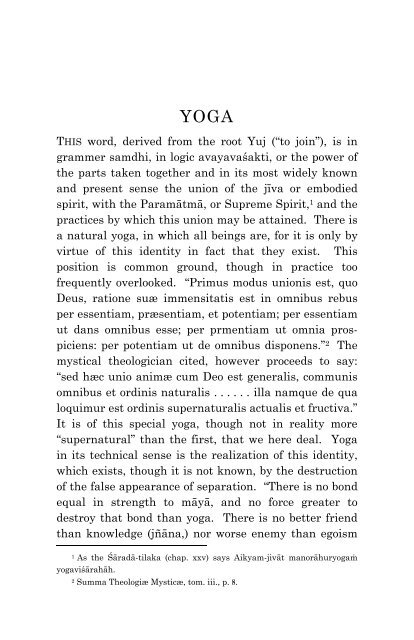Introduction to Tantra Sastra - Aghori
Introduction to Tantra Sastra - Aghori
Introduction to Tantra Sastra - Aghori
You also want an ePaper? Increase the reach of your titles
YUMPU automatically turns print PDFs into web optimized ePapers that Google loves.
YOGA<br />
THIS word, derived from the root Yuj (“<strong>to</strong> join”), is in<br />
grammer samdhi, in logic avayavaśakti, or the power of<br />
the parts taken <strong>to</strong>gether and in its most widely known<br />
and present sense the union of the jīva or embodied<br />
spirit, with the Paramātmā, or Supreme Spirit, 1 and the<br />
practices by which this union may be attained. There is<br />
a natural yoga, in which all beings are, for it is only by<br />
virtue of this identity in fact that they exist. This<br />
position is common ground, though in practice <strong>to</strong>o<br />
frequently overlooked. “Primus modus unionis est, quo<br />
Deus, ratione suæ immensitatis est in omnibus rebus<br />
per essentiam, præsentiam, et potentiam; per essentiam<br />
ut dans omnibus esse; per prmentiam ut omnia prospiciens:<br />
per potentiam ut de omnibus disponens.” 2 The<br />
mystical theologician cited, however proceeds <strong>to</strong> say:<br />
“sed hæc unio animæ cum Deo est generalis, communis<br />
omnibus et ordinis naturalis . . . . . . illa namque de qua<br />
loquimur est ordinis supernaturalis actualis et fructiva.”<br />
It is of this special yoga, though not in reality more<br />
“supernatural” than the first, that we here deal. Yoga<br />
in its technical sense is the realization of this identity,<br />
which exists, though it is not known, by the destruction<br />
of the false appearance of separation. “There is no bond<br />
equal in strength <strong>to</strong> māyā, and no force greater <strong>to</strong><br />
destroy that bond than yoga. There is no better friend<br />
than knowledge (jñāna,) nor worse enemy than egoism<br />
1 As the Śāradā-tilaka (chap. xxv) says Aikyam-jivāt manorāhuryogaṃ<br />
yogaviśārahāh.<br />
2 Summa Theologiæ Mysticæ, <strong>to</strong>m. iii., p. 8.

















